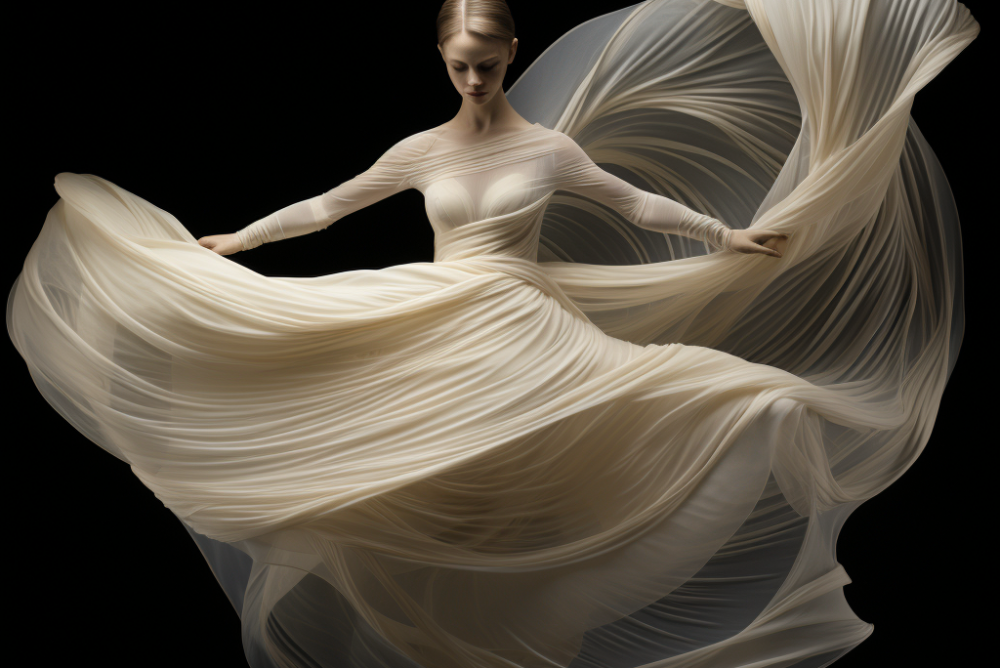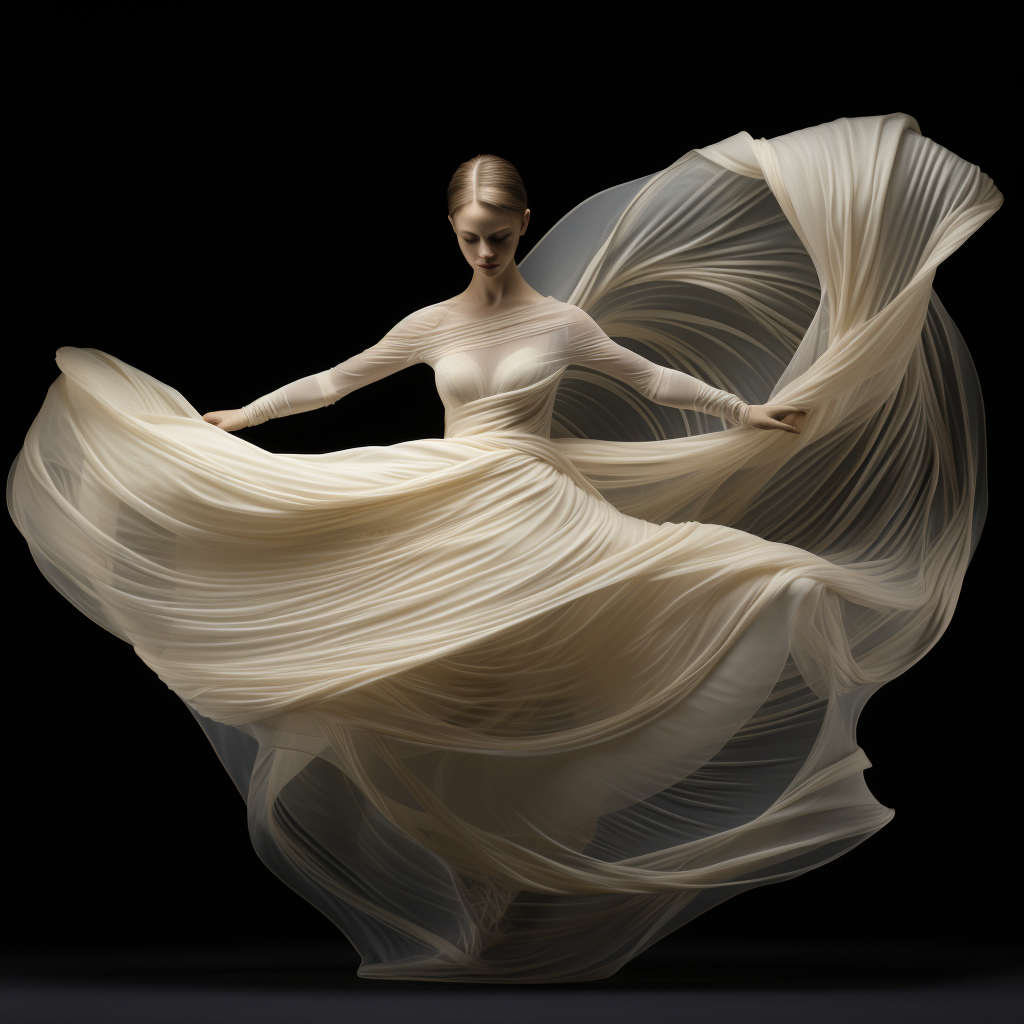Harmony in Motion: Exploring Fabric & Body Dynamics

Introduction:
Definition of Basic Body Movements
Body movements are fundamental to human interaction with the world. They are diverse and integral to expressing emotions, performing tasks, and communicating. This article explores movements that form the building blocks of human activity, delving into their complexity and variety, and outlining their classifications and mechanics.
Role of Fabric Folds
Fabric folds are more than mere wrinkles or pleats in clothing. They are structured or fluid formations in fabrics that occur due to body movements, garment fit, or design. The exploration of fabric folds is crucial for understanding their role in accentuating or restricting body movements and their implications in fashion and apparel design.
Interaction between Body Movement and Fabric Folds
The interaction between body movements and fabric folds is a fascinating dance of physics and art. As the body moves, fabric reacts, creating dynamic shapes and patterns, which are essential for designers to understand to create aesthetically pleasing and functional garments. This interplay is multifaceted, and its comprehension is crucial in various domains such as fashion, sports, and healthcare.
Understanding Basic Body Movements
Types of Basic Body Movements
Basic body movements are the foundational actions performed by the human body. They form the essence of every physical activity we engage in. The main types of basic body movements include:
- Locomotion: This involves moving the body from one place to another, exemplified by walking, running, jumping, and crawling.
- Manipulation: This pertains to interacting with objects, such as lifting, pushing, pulling, and throwing.
- Stabilization: This includes movements that maintain posture and balance, essential for activities like standing, sitting, and balancing on one leg.
- Exploring these fundamental movements provides a scaffold to understand the complex array of human activity and its impact on the fabrics we adorn.
Anatomy and Biomechanics of Movement
The human body is a marvel of biomechanics, where bones, muscles, tendons, and ligaments work in concert to produce movement. The skeletal system provides the structural framework, while muscles generate force to initiate motion. The intricate interplay of these components is governed by the principles of biomechanics, which study the mechanical aspects of living organisms.
Understanding the anatomy involved in movements allows for insights into how different body parts contribute to actions and how fabric interacts with the body during various activities. For instance, the range of motion in joints impacts the degree of fabric stretch and fold.
Importance of Body Movement in Daily Life
Body movements are indispensable to our daily lives. They enable us to interact with our environment, perform tasks, and express emotions. They impact our quality of life, affecting our ability to work, participate in recreational activities, and fulfill our roles in society. Additionally, movement is crucial for maintaining health, promoting physical fitness, and preventing diseases.
Comprehending the importance of body movement is vital for assessing its interaction with fabrics. The manner in which fabrics conform or resist body movements can greatly influence comfort, functionality, and aesthetics in clothing design.
Anatomy of Fabric Folds
Definition and Importance of Fabric Folds
Fabric folds are integral elements in the field of apparel and fashion. They are the bends, creases, and pleats that occur in fabric due to body movements, garment structure, or intentional design. The dynamics of fabric folds play a pivotal role in determining the drape and fit of a garment, influencing both aesthetics and functionality.
Folds are consequential in enhancing or diminishing the visual appeal of a garment. They can also impact comfort, as improperly placed folds may cause discomfort or restriction of movement. Therefore, a profound understanding of fabric folds is crucial for designers aiming to create garments that are both attractive and comfortable.
Various Types of Fabric Folds
Fabric folds are diverse and vary based on factors like fabric type, garment construction, and body movement. Some main types of fabric folds include:
- Pipe Folds: These are cylindrical folds created by compressing fabric, often seen in draped curtains and some garment designs.
- Zig-Zag Folds: These folds appear in an accordion-like manner, commonly found in pleated skirts.
- Spiral Folds: These are created when fabric wraps around a conical or cylindrical form, evident in twisted or wrapped garments.
- Drop Folds: These occur when fabric hangs freely, often seen in loose and flowing garments.
Understanding the different types of folds provides insights into how they can be manipulated or naturally occur, impacting the overall look and feel of a garment.
Factors Influencing Fabric Folds
Several factors influence the formation of fabric folds, including fabric properties, garment construction, and wearer’s movement. The intrinsic characteristics of fabric such as weight, stiffness, and elasticity directly impact the formation and appearance of folds. For example, lightweight fabrics like silk and chiffon form soft, flowing folds, while heavier fabrics like denim and wool create more structured and pronounced folds.
Garment construction also plays a pivotal role, as the way a garment is cut, stitched, and structured affects how fabric conforms to the body, creating distinctive fold patterns. Additionally, the wearer’s movements induce dynamic folds, reflecting the interplay between the body and the fabric, essential for creating garments that harmonize with the human form.
Interaction of Body Movements and Fabric Folds
How Body Movements Affect Fabric Folds
The dance between body movements and fabric folds is a harmonious interaction steeped in complexity. When the body moves, it creates a dynamic interplay with the fabric, affecting its drape, appearance, and the formation of folds. For example, the act of bending an elbow can create a series of accordion-like folds in a sleeve, reflecting the biomechanics of the movement.
Each movement brings about a distinct alteration in the fabric, forming folds that are transient and variable. This dynamic interaction is vital for designers to understand, as it impacts the garment’s functionality, comfort, and visual appeal. Creating designs that complement natural body movements ensures a harmonious fusion of form and function.
The Impact of Fabric Characteristics on Movement
The inherent properties of fabrics—such as elasticity, weight, and texture—significantly impact how they interact with body movements. Elastic fabrics like spandex adapt and stretch with movements, minimizing the restriction and offering comfort, making them ideal for athletic wear. In contrast, stiffer fabrics like denim might limit the range of motion but provide a structured and defined appearance.
Understanding the influence of fabric characteristics on movement is crucial for creating garments that are functional, comfortable, and aesthetically pleasing. It enables designers to select appropriate fabrics that align with the intended use of the garment, balancing aesthetics and functionality.
Case Studies of Different Fabrics and Movements
To illustrate the interaction between body movements and fabric folds, let’s consider a couple of brief case studies:
- Athletic Wear: Athletic wear typically employs fabrics like polyester and spandex, which are lightweight, breathable, and stretchable. These fabrics accommodate a wide range of movements, such as running and jumping, allowing the creation of folds that are transient and adaptive, optimizing performance and comfort.
- Evening Gowns: Evening gowns often use luxurious fabrics like silk and satin, which drape elegantly and form soft, flowing folds. Movements such as walking and dancing induce graceful folds that enhance the aesthetic appeal of the gown, reflecting the symbiosis between elegance and motion.
Practical Applications and Implications
Design Considerations
Understanding the symbiotic relationship between body movements and fabric folds provides designers with the insight needed to create garments that are both aesthetically pleasing and functional. Design considerations should include the selection of appropriate fabrics that align with the intended use of the garment and the movements of the wearer. For example, the use of flexible, breathable fabrics is essential for activewear, allowing for a wide range of motion and comfort during physical activities.
The placement and formation of folds also need to be carefully considered, as they can enhance or hinder the garment’s overall appeal and functionality. Strategically placed folds can accentuate the body's form, create visual interest, and even improve the fit of the garment, making the design process a thoughtful integration of art and science.

Innovations in Fabric and Design
The constant evolution in the field of textile technology is propelling innovations in fabric and design. The development of smart fabrics, which can change their properties based on external conditions or user input, is revolutionizing the interaction between body movements and fabric folds. These innovations allow for the creation of adaptive clothing that can modify its form, functionality, and appearance in real-time, offering unprecedented customization and versatility.
Examples include fabrics that can alter their permeability based on temperature and humidity, allowing for optimal breathability and temperature regulation, and fabrics that can modify their elasticity, providing adjustable support and fit.
Sustainability and Ethical Considerations
In the modern fashion landscape, sustainability and ethical considerations are paramount. The interaction between body movements and fabric folds plays a role in promoting sustainable practices in fashion design. The use of sustainable fabrics and designs that accommodate natural body movements can contribute to the longevity and versatility of garments, reducing the need for frequent replacements and thus mitigating environmental impact.
Ethically, considering the diverse range of body types and movements in design practices promotes inclusivity and accessibility in fashion, enabling individuals of all shapes, sizes, and abilities to experience comfort, functionality, and style.
Conclusion:
The exploration of body movements and fabric folds is a journey through the intricate dance between form and function, aesthetics and comfort. It is an insightful delve into the harmonious interplay between the human body and the fabrics it adorns, highlighting the myriad of ways in which this interaction shapes the field of design and fashion.
By contemplating the various facets of body movements and fabric folds, from basic anatomy and biomechanics to diverse types of fabric folds and their interactions, we gain a holistic understanding of their significance in the creation of garments. This comprehensive insight is essential for designers and enthusiasts seeking to appreciate the elegance and complexity inherent in the world of fashion, allowing for the creation of garments that are a harmonious blend of beauty, comfort, and functionality.






-500x500.jpg)
-500x500.jpg)
-500x500.jpg)
-500x500.jpg)
-500x500.jpg)